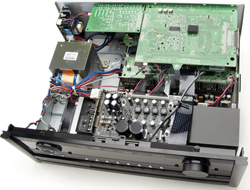Question
I saw two receivers that I am interested in…both of them were specified as having 100 watts x 5 in the power amps. One receiver was priced at $699, the other at $1499. What might I expect the differences to be when the specification were the same?
-Steve E.
Spokane, Washington

Answer:
The short answer to your question is…not enough information to give you a satisfying answer. The specifications you provide are incomplete, and may not be the same at all.
Let’s discuss how to read power ratings for A/V receivers (AVRs) and separate amps more generally. Customarily, power rating for stereo amplifiers are specified as follows: continuous power output per channel into 8?, with both channels driven from 20Hz-20kHz, with 0.1% distortion or less. However, AVR manufacturers often provide power ratings that, while both legal and technically accurate, deviate from the customary standards to make their amplifiers appear more powerful. Some common differences:
- listing “peak” or “dynamic” power rather than continuous power:
- listing power at 6? rather than at 8?;
- measuring power at just one frequency, typically 1kHz, rather than over the whole 20Hz-20kHz bandwidth;
- measuring power with just one channel driven; and
- relaxing the distortion threshold to 1% or higher.
To further muddle matters, some AVR makers go the other way and measure power output under more rigorous conditions. They may specify a lower distortion threshold to highlight cleaner circuitry, or provide an “all channels driven” power rating to showcase a beefy power supply. While over $1500, one example of an AVR with very rigorous power ratings is the Arcam AVR750 recently reviewed and bench tested by Chris Heinonen.
So read the fine print on amplifier power ratings!
But note that so far I’ve only written about differences on paper. The reason is that these specifications don’t tell much of anything about any audible differences that may exist between the two AVRs. Any audible differences between any two AVRs will likely come from somewhere other than the amps, unless your room is very large or your speakers are atypically hard to drive. In fact, the room correction system is where most sonic differences between AVRs lie. The only way to tell if you like the target curve and implementation of any given room correction system in your room with your speakers is to try it and listen! For more on room correction systems, see Piero Gabucci’s recent review of the Diracs Live! software and Dr. David’s Rich’s thorough investigation of Anthem’s ARC system.
As for differences that don’t necessarily relate to sound quality, a $1500 AVR will likely be more feature rich than a $700 AVR. The $1500 AVR should have preouts to allow use of an external amp, and a 12V (remote) trigger output to turn on/off other components. I think it is fair to say that a $1500 AVR must have preouts and a 12V trigger to merit a recommendation from SECRETS. By contrast, an otherwise good $700 AVR can merit a high recommendation even without those features. Also, since you didn’t give brands or models, you’ll want to check on the excellent chart Dr. David Rich provided in “AVR Build Quality: Part I” to compare the quality of parts used in the digital sections of select AVRs across a wide spectrum of brands.
As Dr. Rich showed, the quality of digital circuitry in AVRs varies quite a bit, and selling price is often not the best guide.
Lastly, many would argue not to worry about the amps built into an AVR anyway: the best use of AVR amplifiers is letting them idle while a beefy separate amp drives your speakers!
-Jay Haider


